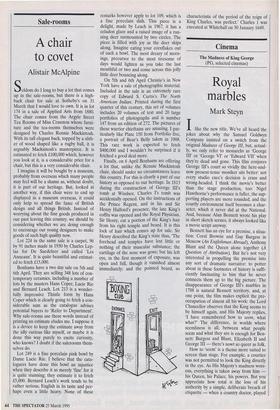Sale-rooms
A chair to covet
Alistair McAlpine
Seldom do I long to buy a lot that comes up in the sale-rooms, but there is a high- back chair for sale at Sotheby's on 31 March that I would love to own. It is in lot 174 in a sale of Applied Arts from 1880. The chair comes from the Argyle Street Tea Rooms of Miss Cranston whose furni- ture and the tea-rooms themselves were designed by Charles Rennie Mackintosh. With its tall elegant back, topped by a slith- er of wood shaped like a rugby ball, it is arguably Mackintosh's masterpiece. It is estimated to fetch £100,000 which, however you look at it, is a considerable price for a chair, but this is a very considerable chair. I imagine it will be bought by a museum, probably from overseas which many people may feel will be a shame as, without doubt, it is part of our heritage. But, looked at another way, if this chair were to end up displayed in a museum overseas, it could only help to spread the fame of British design and all things British. Instead of worrying about the fine goods produced in our past leaving this country, we should be considering whether we are doing enough to encourage our young designers to make goods of such high quality now. Lot 224 in the same sale is a carpet, 96 by 91 inches made in 1930 by Charles Lep- lae for De Saedeleer and called 'Les Anneaux'. It is quite beautiful and estimat- ed to fetch £15,000. Bonhams have a two day sale on 5th and 6th April. They are selling 348 lots of con- temporary ceramics, including a number of lots by the masters Hans Coper, Lucie Rie and Bernard Leach. Lot 213 is a wonder- fully impressive Thistle form by Hans Coper which is clearly going to fetch a con- siderable sum as the catalogue advises potential buyers to 'Refer to Department'. Why sale-rooms use these words instead of printing an estimate eludes me. I suppose it is a device to keep the estimate away from the idly curious like myself, or maybe it is done this way purely to excite curiosity, who knows? I doubt if the salerooms them- selves do. Lot 249 is a fine porcelain pink bowl by Dame Lucie Rie. I believe that the cata- loguers have done this bowl an injustice when they describe it as merely 'fine' for it is quite stunning; they estimate it to fetch £5,000. Bernard Leach's work tends to be rather serious, English in its taste and per- haps even a little heavy. None of these remarks however apply to lot 109, which is a fine porcelain dish. This piece is a delight, made by Leach in 1967, it has a celadon glaze and a raised image of a run- ning deer surmounted by two circles. The piece is filled with joy as the deer skips along. Imagine eating your cornflakes out dreary of such a bowl. The most dr of morn- ings, precursor to the most tiresome of days would lighten as you take the last and come across this jolly mouthful or two lly little deer bouncing along. On 5th and 6th April Christie's in New York have a sale of photographic material. Included in the sale is an extremely rare copy of Edward S. Curtis's The North American Indian. Printed during the first quarter of this century, this set of volumes includes 20 volumes of text and 20 large portfolios of photographs and is number 147 from an edition of 272. The pictures of these warrior chieftains are amazing. I par- ticularly like Plate 150 from Portfolio five, a portrait of Bear's Belly taken in 1908. This rare work is expected to fetch $400,000 and I wouldn't be surprised if it fetched a good deal more. Finally, on 6 April Bonhams are offering a lot that, unlike the Rennie Mackintosh chair, should under no circumstances leave this country. For this is clearly a part of our history as opposed to our heritage. In 1813 during the construction of George III's tomb at Windsor, Charles I's tomb was accidentally opened. On the instructions of the Prince Regent, and in his and Sir Henry Halford's presence, the late King's coffin was opened and the Royal Physician, Sir Henry, cut a portion of the King's hair from his right temple and beard. It is this lock of hair which comes up for sale. Sir Henry described the King's state thus, 'The forehead and temples have lost little or nothing of their muscular substance; the cartilage of the nose was gone; but his left eye, in the first moment of exposure, was open and full, though it vanished almost immediately; and the pointed beard, so characteristic of the period of the reign of King Charles, was perfect.' Charles 1 was executed at Whitehall on 30 January 1649.


























































 Previous page
Previous page